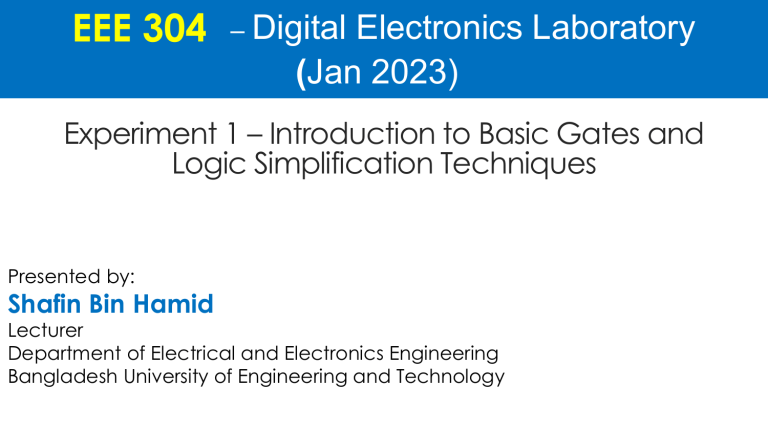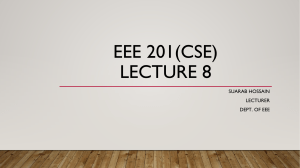
EEE 304 – Digital Electronics Laboratory (Jan 2023) Experiment 1 – Introduction to Basic Gates and Logic Simplification Techniques Presented by: Shafin Bin Hamid Lecturer Department of Electrical and Electronics Engineering Bangladesh University of Engineering and Technology Mid Term Presentation (April 2021) Outline • Basic Boolean gates • Boolean algebra • Minimization using Boolean algebra • Truth table to Sum of Products (SOP) • Truth table to Product of Sums (POS) • Minimization using Karnaugh map EEE 304 (July 2022) – Experiment 1: Introduction to Basic Gates and Logic Simplification Techniques © Shafin Bin Hamid 2 Basic Boolean gates AND OR NOT In the absence of parentheses, the precedence of operation is NOT > AND > OR EEE 304 (July 2022) – Experiment 1: Introduction to Basic Gates and Logic Simplification Techniques © Shafin Bin Hamid 3 Boolean algebra All theorems maintain duality. Replace + with . and replace 1 with 0 Axioms Single Variable Thm. Two/Three Variable Thm. EEE 304 (July 2022) – Experiment 1: Introduction to Basic Gates and Logic Simplification Techniques © Shafin Bin Hamid 4 Minimization using Boolean algebra EEE 304 (July 2022) – Experiment 1: Introduction to Basic Gates and Logic Simplification Techniques © Shafin Bin Hamid 5 Cost of an implementation • The cost of a logic circuit is the total number of gates plus the total number of inputs to all gates in the circuit Cost of Implementation: Total gates = 3+4+1 = 8 Total inputs = 3+3+3+3+3+4 = 19 Total = 27 Cost of Implementation: Total gates = 2+2+1 = 5 Total inputs = 2+2+2+2 = 8 Total = 13 EEE 304 (July 2022) – Experiment 1: Introduction to Basic Gates and Logic Simplification Techniques © Shafin Bin Hamid 6 Sum of Products • For a function of n variables, a product term in which each of the n variables appears once is called a minterm. • The variables may appear in a minterm either in uncomplemented or complemented form. For a given row of the truth table, the minterm is formed by including xi if xi = 1 and by including 𝑥ഥ𝑖 if xi = 0 EEE 304 (July 2022) – Experiment 1: Introduction to Basic Gates and Logic Simplification Techniques © Shafin Bin Hamid 7 Sum of Products • Any function f can be represented by a sum of minterms that correspond to the rows in the truth table for which f = 1 • The resulting implementation is functionally correct and unique, but it is not necessarily the lowest-cost implementation of f . • If each product term in a sum of products expression, f is a minterm, then the expression is called a canonical sum-of-products for the function f. 𝒇 𝒙𝟏 , 𝒙𝟐 , 𝒙𝟑 = 𝒎𝟏 + 𝒎𝟒 + 𝒎𝟓 + 𝒎𝟔 EEE 304 (July 2022) – Experiment 1: Introduction to Basic Gates and Logic Simplification Techniques © Shafin Bin Hamid 8 Product of Sums • It is also possible to synthesize f by considering the rows for which f = 0. (from Principle of duality) • This alternative approach uses the complements of minterms, which are called maxterms. EEE 304 (July 2022) – Experiment 1: Introduction to Basic Gates and Logic Simplification Techniques © Shafin Bin Hamid 9 NAND for SOP EEE 304 (July 2022) – Experiment 1: Introduction to Basic Gates and Logic Simplification Techniques © Shafin Bin Hamid 10 NOR for POS EEE 304 (July 2022) – Experiment 1: Introduction to Basic Gates and Logic Simplification Techniques © Shafin Bin Hamid 11 Karnaugh maps • A systematic way of producing a minimum-cost logic expression Two variable map Four variable map Three variable map The least significant variables should be placed along the rows of the Karnaugh map The adjacent combinations cannot differ by more than 1 bit, i.e. gray coding EEE 304 (July 2022) – Experiment 1: Introduction to Basic Gates and Logic Simplification Techniques © Shafin Bin Hamid 12 Karnaugh map minimization (SOP) Steps: Draw the K-map and place the 1’s according to the defined function. EEE 304 (July 2022) – Experiment 1: Introduction to Basic Gates and Logic Simplification Techniques © Shafin Bin Hamid 13 Karnaugh map minimization (SOP) Then, find the largest groups of 1’s that is a power of 2 (2,4,8,16 etc). You need to make sure that the 1’s are adjacent to each other. Once you have found a group, you will need to write the minterm for it. Of x1, x2, x3 etc. some will remain constant within the group and some will change. Only those that remain constant within the group will appear in the minterm in either complemented or uncomplemented form. EEE 304 (July 2022) – Experiment 1: Introduction to Basic Gates and Logic Simplification Techniques © Shafin Bin Hamid 14 Karnaugh map minimization (SOP) • Continue doing this for all groups of 4 EEE 304 (July 2022) – Experiment 1: Introduction to Basic Gates and Logic Simplification Techniques © Shafin Bin Hamid 15 Karnaugh map minimization (SOP) • Once groups of 4 are finished, look for groups of 2 • Remember that for a group to be valid, there needs to be at least 1 non-common one inside it • Once all one’s have been covered, just sum up the minterms and you have the minimum cost SOP EEE 304 (July 2022) – Experiment 1: Introduction to Basic Gates and Logic Simplification Techniques © Shafin Bin Hamid 16 Karnaugh map minimization (POS) • Most rules are same except now instead of minterms we will have maxterms and instead of grouping ones, we will group zeros • Eventually, we will multiply all the maxterms to get minimum cost POS • Remember that now if xn is 0, we will take the uncomplemented form (different from SOP) EEE 304 (July 2022) – Experiment 1: Introduction to Basic Gates and Logic Simplification Techniques © Shafin Bin Hamid 17 Karnaugh map minimization (Don’t care terms) Don’t care terms can be taken as 0 or 1 depending on SOP or POS minimization EEE 304 (July 2022) – Experiment 1: Introduction to Basic Gates and Logic Simplification Techniques © Shafin Bin Hamid 18 Reference • Chapter 2, Stephen Brown, Zvonko Vranesic - Fundamentals of Digital Logic with Verilog Design (3rd Edition) EEE 304 (July 2022) – Experiment 1: Introduction to Basic Gates and Logic Simplification Techniques © Shafin Bin Hamid 19 EEE 304 (July 2022) – Experiment 1: Introduction to Basic Gates and Logic Simplification Techniques © Shafin Bin Hamid 20






